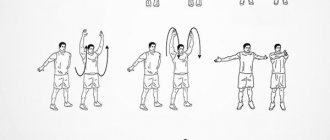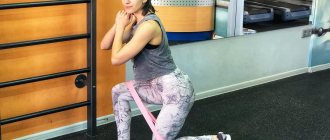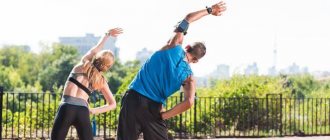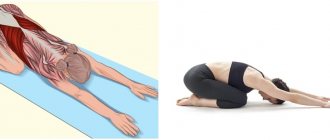Before each workout, you must warm up. It includes a set of exercises aimed at preparing the body for intense physical activity. During warm-up, body temperature rises and muscles warm up. As a result, sprains are prevented and the risk of injury during sports activities is reduced, and training becomes as effective as possible.
- Why do you need a warm-up?
- The benefits of warming up
- Why is its absence dangerous?
- What are the types and techniques of execution?
- Dynamic
- Static
- Other exercises and recommendations
The need for exercise before training
Stretching the muscles before training, especially after a night's sleep, is extremely necessary, as it allows you to:
- stretch muscles that are tight and the joints themselves are inactive;
- prepare the body for more serious physical exercise (without it, you can quickly sprain ligaments or get other injuries);
- ensuring a normal level of metabolism, which is very important during the training phase.
To ensure that warm-up and stretching before training are done correctly, allocate 15-20 minutes to this process. The first 10 minutes should be aimed at warming up the muscles.
It is recommended to start any muscle training with a warm-up.
To do this, you should perform the following exercises:
- A short jog.
- Squats that do not use weights.
- Warm-up with a skipping rope.
- Bench press.
After doing the warm-up exercises, you can proceed directly to muscle stretching. Please note that the warm-up should not replace the main training time.
Features of warming up at home
It’s worth saying a little more about why you need a warm-up before training at home. When we practice, we try to give our best. At the same time, the body is exposed to loads that it does not receive in everyday life. The main impact is placed not only on the muscles, but also on the joints and tendons. To prevent the load from becoming too much stress for the body, it needs preparation for this. Warming up helps to warm up, thereby improving metabolic processes and giving the joints the necessary amount of lubrication, which prevents early wear of cartilage tissue. The flow of blood makes the tendons more elastic, and they can ultimately withstand greater loads with minimal risk of rupture. People who are new to sports may underestimate the importance of warming up, which increases the risk of injury. If you want exercise to be safe and effective, don't skip warming up.
Of course, exercising outdoors is great, especially in the morning. But due to weather conditions, such luxury is not always available. Many people go to gyms, but some don’t see the point in it or don’t have the opportunity for one reason or another. An alternative could be practicing at home - for non-professionals this will be quite enough.
Before you start exercising, ventilate the room so that it is filled with fresh air. This way, each of your cells will be better saturated with oxygen.
Warming up before training at home for girls or men may differ depending on the characteristics of the workout itself and the body. Keep in mind that activities should also be fun, so choose what you like best. This could be running in place, jumping rope, squats, or simple exercises that include basic exercises. But keep in mind that it is important to warm up the whole body, and not a separate part of it, so that blood circulates evenly throughout the body.
Warming up at home should help you increase your heart rate to 130-160 beats. This can be achieved by actively exercising for five minutes. Pay enough attention to the joints of the knees and shoulders, where rotational movements can be used. Don't bypass the spine either. To warm it up, rotate your torso, increasing the amplitude over time. The warm-up includes three main parts and:
- General warming up of the body;
- Working out the joints;
- Stretching.
Simply walking in place for five minutes helps warm up your torso before major exercises. In the process, you can swing your arms - rotationally or from bottom to top. In this way, individual joints can be worked on.
You can also use squats . They warm up well and strengthen the hips and legs. They help warm up the joints of the legs and spine. A jump rope is suitable for an intense warm-up. Jumping not only strengthens muscles and joints, but also helps restore breathing, improving lung function. It is enough to jump for 3-5 minutes, but the effect may be better than from other types of warm-up. This is a high-quality warm-up of the whole body.
Types of stretch marks
Stretching before strength training is an important element for every athlete, and it can be:
Dynamic
Dynamic stretching involves performing exercises in a constant manner without reducing speed. Due to the fact that the same rather short elements will be repeated many times, the amplitude will increase.
Static
The peculiarity of static stretching is that the adopted pose must be held for about 30 seconds, followed by increasing the stretch of the trained muscles to the maximum value. After 30–60 seconds after performing static stretching, complete muscle relaxation occurs.
Remember that the purpose of stretching before training is not to increase your flexibility and plasticity, but to prevent muscle injuries and prepare the whole body for work
Note! When performing both dynamic and static exercises, a person should not feel pain, and all movements should only be done smoothly and slowly, gradually increasing the amplitude.
When is it better to stretch: before or after a workout?
For some, stretching is an addition to training, for others it is useful, but an optional component, like a cherry on top of a cake - you want to try it, but it is not at all necessary. Or maybe you think that stretching and massaging your toes for a few seconds after you've gone all out on the treadmill isn't necessary? It turns out that when and how you stretch your muscles (before or after training) can make or break your fitness goals.
Stretching: what is it and what is it eaten with?
Stretching is a set of exercises that are performed before or after the main workout in order to develop ligaments and joints, tone muscles, work out all segments of the spine, and warm up the body. Most often, stretching includes a set of aerobic exercises that saturate muscles and tissues with oxygen, making them more elastic and ready for intense exercise. Stretching can be static or dynamic. Stretching speeds up metabolic processes, promotes the release of adrenaline into the blood, which subsequently increases endurance and helps you train more intensely.
Move over!
“Stretching before exercise is critical to preventing injury as well as improving the body's performance. Especially if you exercise immediately after waking up, or if you are sedentary during the day, then your muscles will be “clogged,” that is, very tight, stiff,” says Noam Tamir, certified trainer and founder of TS Fitness. Recent fitness research has shown that proper stretching 15 minutes before exercise can help you avoid many injuries.
So what steps should we take? "It's best to do a dynamic warm-up before your workout," says Tamir. Unlike static exercises, which are done for 30 seconds or more in one position, this type of stretching involves active movements that mimic the actual exercises you'll do during your actual workout. For example, runners often perform dynamic stretches such as walking lunges and leg kicks to activate the exact muscle groups that will be used during the workout. "During dynamic stretching, you're constantly moving, so it provides you with a cardio warm-up," explains Julie Mulcahy, D.S., a physical therapist.
Not only will stretching help you reduce your risk of injury, but dynamic stretching has been proven to significantly improve your athletic performance. Research shows that college athletes who performed dynamic warm-ups for four weeks before a major competition saw improvements in strength, endurance, agility and power. Other studies show that dynamic muscle stretching improves performance and power compared to static stretching.
The problem with static stretching
What are the problems with static stretching? The fact is that for many, the thought of doing a mini-workout before the actual workout sounds exhausting; many of us, instead of resorting to a few stretching movements before class, do more active cool-down after training. “Static stretching, as opposed to dynamic stretching, helps relax muscles and develop flexibility,” says Tamir.
However, recent research has questioned the benefits of static stretching before exercise, suggesting that it may lead to decreased athletic performance. One study found that performing static stretching before performing barbell squats caused people to feel more insecure and lift less weight. At the same time, another study showed that football players who did static stretching before a 30-meter sprint were many times slower than those players who did not stretch before the sprint. A meta-analysis of over a hundred studies concluded that static stretching had a negative impact on strength, power, and performance and should be avoided altogether.
Some studies show that stretching is not very helpful in relieving muscle pain. After analyzing 12 studies, researchers found that stretching before or after exercise did not prevent annoying muscle pain.
The question arises, if stretching does not prevent joint and muscle pain, then how does it help prevent injury? In this regard, American scientists conducted six randomized studies, which showed that the difference in the number of injuries received during training in people who did stretching and those who refused it did not differ.
Let's draw the line
Best practice: Spending some time doing dynamic stretching before your workout can help prepare you to warm up, preparing your muscles and improving your athletic performance. Therefore, if you weigh the pros and cons of stretching, there are still many more advantages to it. Julie Mulcahy says static stretching can be beneficial for people who spend a lot of time sitting at a desk. She involves performing static stretches for the hamstrings, hips, shoulders, and back muscles (post-workout) several times a week.
It turns out that stretching doesn’t really affect anything? So is it needed? This question was well answered by Rob Herbert, a doctor of sports medicine from the Sydney Health Institute in Australia: “If stretching makes you happy, keep doing it, there will be no harm from it, that’s for sure.”
Finally, be sure to consult with a certified trainer to work with you to develop the plan that best suits your fitness level and athletic goals.
Features of dynamic stretching
Dynamic stretching can be the most necessary element, carried out during the warm-up period. Its features include:
- the ability to keep the body warm throughout the entire workout;
- Stretching exercises before training will help increase the body's performance;
- the muscle tension created by dynamic stretching will help runners quickly gain speed, and bodybuilders will increase their sense of balance;
- when performing a dynamic warm-up, it is important to repeat all exercises approximately 5-6 times with a delay of no more than 5 seconds;
- the key role should be given to those exercises that will create an imitation of real training elements.
When dynamic stretching is performed correctly, many problems with a person’s physical health can be avoided.
What to include in dynamic stretching?
Warm up well before stretching. Very good. Muscles need to be “hot”
A set of exercises that are advisable to perform during dynamic stretching include:
- For the neck: bending and turning the head; smooth rotation in a circle.
- For the chest and back: stretching your arms, fastened in a lock in front of you, with your back forward and smoothly moving them in the opposite direction.
- For shoulders: swing your arms; circular movements and raising the shoulders up and down.
- For the body: rotational movement of the pelvis; turns the waist and bends in different directions.
- For the arms: performing circular movements in both the elbow and shoulder joints.
- For legs: tilt towards the feet; circular movements of the knees and feet; lunges forward and to the sides.
This set of exercises will be enough to perform high-quality dynamic stretching.
Stretching muscles before training[edit | edit code]
Neck stretch
Press your chin toward your chest so that the muscles in the back of your neck stretch. Stay in this position for a few seconds.
Trapezius stretch
- Grab your head with one hand.
- Slowly lower your head down, ear to shoulder, until it becomes uncomfortable.
- Hold for 20-30 seconds. Repeat several times. Then repeat all over again in the other direction.
Neck rotation
- Starting position: standing with your feet shoulder-width apart.
- Keeping your chin level, turn your neck to the side as far as you can.
- Return to the starting position and repeat the rotation in the opposite direction. Repeat this exercise several times.
Stretching the pectoral muscles on the counter
- Place your hand on a wall or any vertical surface and bend your elbow 90 degrees.
- Lean forward with your whole body and slightly to the side of your arm until you feel the tension in your pectoral muscles.
- Stay in this pose for a while and then repeat the exercise on the other side.
Pectoral muscles
- Stand in a vertical position and pull your outstretched arms back, while keeping them locked.
- Raise your arms toward the ceiling, keeping them straight, until you feel a stretch in your pectoral muscles.
Back
Grasp a post or pole with one hand and lean back, straightening your legs, so that your back muscles stretch. Hold this position for the recommended number of seconds and repeat the exercise with the other arm.
Obliques
Place one hand on your belt and tilt your torso in this direction, while reaching for your hand. Then repeat on the other side.
Triceps stretch
- Sit or stand in an upright position.
- Place one bent arm so that the palm is level with the base of the neck, and with the other hand, grab the elbow and pull until you feel a stretch in the triceps (at the back of the shoulder)
- Hold for 20-30 seconds. Repeat on the other side.
Stretching the posterior delta band
- Sit or stand in an upright position.
- Pull your elbow on the opposite side until you feel a stretch in the back of your shoulder.
- Hold for 20-30 seconds. Repeat on the other side.
- As you pull your elbow, make sure your forearm remains perpendicular to the floor (fingers pointing down).
Shoulder rotation
- Starting position: standing with your feet shoulder-width apart.
- Raise your arms up to shoulder height and begin rotating your shoulders and torso to the side until it stops.
- Return to the starting position and repeat on the other side. And so on several times.
Chest stretch
- Raise your arms and move them 90° away from your body. Bend your elbows at a 90° angle.
- Place your hands behind your head and pull your elbows back until you feel a stretch in your chest.
- Hold for 20-30 seconds. Repeat several times.
- Remember, keep your lower back straight.
Stretching for legs before training[edit | edit code]
Lunges:
- Starting position: standing with your feet shoulder-width apart.
- Take a step back with one leg, while bending your knee into a lunge position.
- Keep your back straight.
- Return to the starting position and repeat several times, then do the same with the other leg.
Side lunges:
- Starting position: legs in a wide stance, hands behind the head.
- Shift your body weight to the side and squat so that your hips “drop” behind your legs.
- Return to the starting position and repeat the same movement on the other side.
- Alternate this movement forward and backward.
Swing your legs
- hamstrings
Anterior thigh stretch
Lift your right leg back and grab your ankle with your hand. Hold for a few seconds, release your leg. Then take a step and repeat the same with the other leg.
Warm up the knee joints
(feet together, grab your knee with your hands and perform circular movements, changing direction)
Features of static stretching
In those moments when you experience slight hitches, it is advisable to move on to static stretching. Features:
- When performing static stretching, you need to pay attention to those muscle groups that the exercises are aimed at;
- the duration of one exercise can be about 30 seconds, but no more;
- when performing static stretching, you should not feel pain, but, on the contrary, a pleasant feeling of stretching;
- to get the best results, all exercises should be carried out calmly, while breathing deeply and measuredly;
- For maximum muscle stretching, the place where static stretching will occur must be warm.
The main task is to prepare the muscles for the load. First warm up, then strengthen the plasticity for the duration of the workout by stretching
Static stretching exercises allow muscles to recover much faster and relieve tension. There is immediate removal of decomposition products.
By adhering to a whole range of prescriptions, static exercises will help you achieve the best results.
Warm-up exercises before training at home
If you choose to exercise at home, warming up helps to significantly increase its effectiveness. Even if running and jumping rope are not available in your apartment, you can find a number of alternatives. You can use the following complex as a warm-up:
- Walking in place. Stand straight, press your arms to your body, place your feet a short distance from each other. Walk in place at an average pace for 3-4 minutes.
- Raise the knees one at a time to the level of the pelvis. Try to do the exercise as quickly as possible so that you can do about 30 reps in half a minute.
- Squats. It will be enough to repeat the exercise 15 times. Please note that when squats, your knees should not go beyond your toes. Focus on your heels. As you lower your body, move your buttocks back. The back can be slightly tilted forward, but the spine should be straight.
- Triceps stretch. You need to raise your arm, bend it at the elbow, and move your forearm back. With your other hand, apply slight pressure to your elbow to stretch the muscle. Do 4-5 reps on each side.
- Shoulder rotation. Do 12 times forward and 12 times back.
- Stretching the chest muscles. You need to put your hands behind your back, rest your hands on your lower back, and point your fingers down. The pelvis needs to be pushed a little, and the chest should be directed forward.
- Stretching the back muscles. You need to clasp your hands and put them in front of you. Round your back, then reach down with your arms. Repeat 6-8 times is enough.
- Stretching the thigh muscles . The leg needs to be bent at the knee and the foot raised to the level of the buttocks. Hold the sock with your hand and gently pull the muscle tissue. It is enough to repeat five times, making five-second delays.
The ideal warm-up duration is 10-15 minutes . If you spend more time on it, your body will begin to get tired and lose the strength that you will still need for the main training. A shorter time may not give the muscles the opportunity to warm up completely. Warm-up should be pleasant and comfortable, it should not quench. But we shouldn’t ignore it either, because we already know about its importance. A video warm-up for beginners at home will help you start your workout correctly and increase its effectiveness.
What exercises are suitable for an ideal warm-up?
If you need to stretch before training at home, then you can use a fairly simple set of exercises:
- Bend forward.
- Raising your knees.
- Lateral bends.
- Rotational movements of the arms.
- Raising the body.
- Exercise "Boat".
- Raising the legs and abducting them.
- Pushups.
- Cardio exercises.
This is an example set of exercises that can be used to stretch before a serious workout.
Stretching before exercise has two purposes: injury prevention and proper form.











